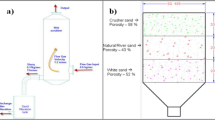Abstract
Wet scrubbers are most important air pollution control devices used in many chemical process industries to remove particulate and acid gases from off gases. Plate scrubbers are medium level energy scrubbers, simple in design and they can be used for the removal of acid gases from the exhaust gas streams which are being released into the environment from various chemical industries. The primary particle removal mechanisms in scrubbing systems are well known where as the actual mechanism which is occurring exactly in the dual-flow sieve plate system is not yet discovered. It is most important to predict the particulate removal capacity of the system to select air pollution control device. Therefore, theoretical estimation of the column efficiency with the model is essential. This paper tries to predict the three stage dual-flow sieve plate column scrubber efficiency theoretically for 1-10 µm range fly ash particles. Dual-flow sieve plate column scrubber particle removal characteristics are analyzed by observing the gas flow rate, liquid flow rate and size of particle effects on overall efficiency. By using the concepts of diffusion, impaction and interception, the particle removal mechanism is analyzed theoretically. A mathematical model has also been suggested to predict the particulate removal efficiency in the dual-flow sieve plate column. More than 100 % removal efficiency is observed for more than 3.5 µm particle size.
Access this chapter
Tax calculation will be finalised at checkout
Purchases are for personal use only
Similar content being viewed by others
References
Cheng, L.: Collection of airborne dust by water sprays. Ind. Eng. Chem. Process Des. Devel. 12, 221–225 (1973)
Flavio, D.M., Liliana, A.F., Nilson, R.M., Vanessa, B., Ronaldo, H.: Review of hydraulics correlations for sieve trays without downcomers. Ind. Eng. Chem. Res. 53, 8323–8331 (2014)
Fuchs, N.A.: The mechanics of aerosols. Pergamon Press, New York (1964)
Hofhuis, P.A.M.:. Flow regimes on sieve trays for gas/liquid contacting, Ph.D. thesis, Delft University of Technology, Delft, Netherlands (1980)
Jung, C., Lee, K.: Filtration of fine particles by multiple liquid droplet and gas bubble systems. Aerosol Sci. Technol. 29, 389–401 (1998)
Kaldor, T.G., Phillips, C.R.: Aerosol scrubbing by foam. Ind. Eng. Chem. Process Design Devel. J. 15, 199–206 (1976)
Kim, H., Jung, C., Oh, S., Lee, K.: Particle removal efficiency of gravitational wet scrubber considering diffusion, interception, and impaction. Environ. Eng. Sci. 18, 125–136 (2001)
Lee, K.W., Gieseke, J.A.: Collection of aerosol particles by packed beds. Environ. Sci. Technol. 13, 466–470 (1979)
Meikap, B., Biswas, M.: Fly-ash removal efficiency in a modified multi-stage bubble column scrubber. Sep. Purif. Technol. 36, 177–190 (2004)
Raj, M.B., Jain, R.K., Meikap, B.C.: Comprehensive analysis for prediction of dust removalefficiency using twin-fluid atomization in a spray scrubber. Sep. Purif. Technol. 63, 269–277 (2008)
Sarkar, S., Meikap, B., Chatterjee, S.G.: Modeling of removal of sulfur dioxide from flue gases in a horizontal concurrent gas–liquid scrubber. Chem. Eng. J. 131, 263–271 (2007)
Wang, Q., Chen, X., Gong, X.: Theoretical and experimental investigation on the characteristics of fly-ash scrubbing in a fixed valve tray column. Am. Inst. Chem. Eng. J. 59, 2168–2178 (2012)
Wang, Q., Chen, X., Gong, X.: The particle removing characteristics in a fixed valve tray column. Ind. Eng. Chem. Res. 52, 3441–3452 (2013)
Wark, K., Warner, G.F., Davis, W.T.: Particulate control. In Air pollution: Its Origin and Control 3rd edn. Addison-Wesley
Yoshida, H., Ono, K., Fukui, K.: The effect of a new method of fluid flow control on submicron particle classification in gas-cyclones. Powder Technol. 149, 139–147 (2005)
Acknowledgments
The authors would like to acknowledge the Department of Science and Technology (DST), Government of India(GOI) and Indian Institute of Technology (IIT) Kharagpur, India for their financial and technical support (sanction No: DST/INT/SA/P-14/2011) of this research.
Author information
Authors and Affiliations
Corresponding author
Editor information
Editors and Affiliations
Rights and permissions
Copyright information
© 2016 Springer Science+Business Media Singapore
About this paper
Cite this paper
Kurella, S., Bhukya, P.K., Meikap, B.C. (2016). Mathematical Modelling on Particulate Removal in Multistage Dual-flow Sieve Plate Column Wet Scrubber. In: Regupathi, I., Shetty K, V., Thanabalan, M. (eds) Recent Advances in Chemical Engineering. Springer, Singapore. https://doi.org/10.1007/978-981-10-1633-2_26
Download citation
DOI: https://doi.org/10.1007/978-981-10-1633-2_26
Published:
Publisher Name: Springer, Singapore
Print ISBN: 978-981-10-1632-5
Online ISBN: 978-981-10-1633-2
eBook Packages: Chemistry and Materials ScienceChemistry and Material Science (R0)




